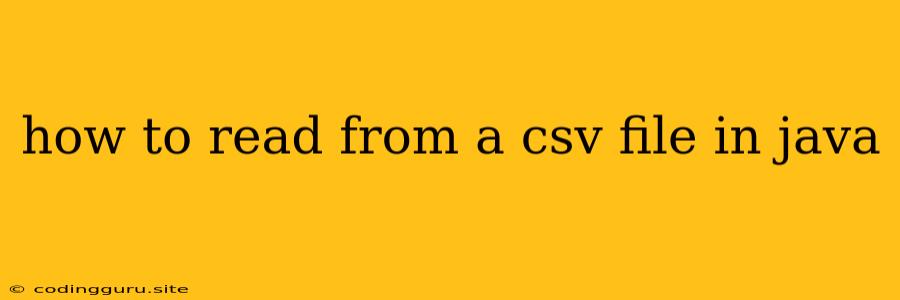How to Read from a CSV File in Java
Reading data from CSV files is a common task in Java programming. CSV files are simple, comma-separated text files that store tabular data in a structured format. This makes them easy to parse and work with in various applications, from data analysis to database management.
Let's dive into how to read from a CSV file in Java using the most popular approaches.
1. Using the java.util.Scanner class
This approach is straightforward and suitable for basic CSV files without complex structures.
Example:
import java.io.File;
import java.io.FileNotFoundException;
import java.util.Scanner;
public class ReadCSV {
public static void main(String[] args) {
try {
File file = new File("data.csv");
Scanner scanner = new Scanner(file);
scanner.useDelimiter(",");
while (scanner.hasNextLine()) {
String line = scanner.nextLine();
String[] values = line.split(",");
// Process each value in the array
for (String value : values) {
System.out.print(value + " ");
}
System.out.println();
}
scanner.close();
} catch (FileNotFoundException e) {
System.out.println("File not found: " + e.getMessage());
}
}
}
Explanation:
- File: Create a
Fileobject representing your CSV file. - Scanner: Use a
Scannerto read the file line by line. - Delimiter: Set the delimiter to a comma using
scanner.useDelimiter(","). - Split: Split each line into an array of values using
line.split(","). - Process: Access each value in the array and perform your desired operations.
2. Using the java.io.BufferedReader class
This method is more efficient for larger files as it reads data in chunks.
Example:
import java.io.BufferedReader;
import java.io.FileReader;
import java.io.IOException;
public class ReadCSV {
public static void main(String[] args) {
try (BufferedReader br = new BufferedReader(new FileReader("data.csv"))) {
String line;
while ((line = br.readLine()) != null) {
String[] values = line.split(",");
// Process each value in the array
for (String value : values) {
System.out.print(value + " ");
}
System.out.println();
}
} catch (IOException e) {
System.out.println("Error reading file: " + e.getMessage());
}
}
}
Explanation:
- BufferedReader: Use a
BufferedReaderfor efficient line-by-line reading. - FileReader: Create a
FileReaderobject to read from the CSV file. - readLine(): Use
br.readLine()to read lines until the end of the file is reached. - Split: Split each line into an array of values.
- Process: Perform operations on the individual values.
3. Using a CSV Library
For more complex CSV files with features like header rows, different delimiters, or quoting mechanisms, dedicated libraries provide a more robust solution.
Example (using OpenCSV):
import com.opencsv.CSVReader;
import com.opencsv.exceptions.CsvException;
import java.io.FileReader;
import java.io.IOException;
import java.util.List;
public class ReadCSV {
public static void main(String[] args) {
try (CSVReader reader = new CSVReader(new FileReader("data.csv"))) {
List records = reader.readAll();
for (String[] record : records) {
for (String value : record) {
System.out.print(value + " ");
}
System.out.println();
}
} catch (IOException | CsvException e) {
System.out.println("Error reading CSV file: " + e.getMessage());
}
}
}
Explanation:
- OpenCSV: Include the OpenCSV library in your project.
- CSVReader: Use a
CSVReaderto read the CSV file. - readAll(): Read all records into a
Listof String arrays. - Process: Iterate through each record and process the values.
Tips for Reading CSV Files
- Handle Delimiters: Consider using a different delimiter than a comma if your CSV file uses a different separator.
- Escape Characters: Be aware of escape characters in your CSV data, particularly for quotes and special characters.
- Header Rows: If your CSV file has a header row, use the library's capabilities to extract the header information.
- Error Handling: Implement robust error handling to handle situations like file not found or invalid data.
Conclusion
Reading data from CSV files in Java is a straightforward task. You can choose the method that best suits your needs based on the complexity of your CSV file. For basic files, the java.util.Scanner or java.io.BufferedReader classes are sufficient. For more advanced scenarios, consider using a dedicated CSV library like OpenCSV to handle features like quoting and custom delimiters.
